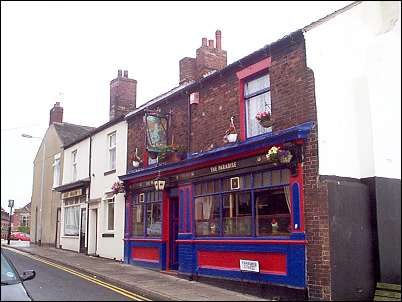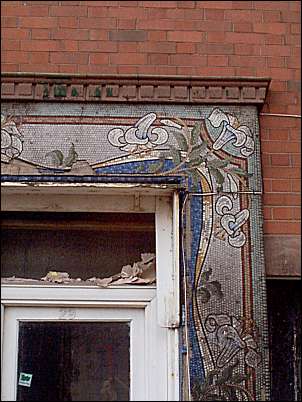|
Paradise Street, Tunstall
  
click the
"contents" button to get back to the main index & map
next: Ash Estate, Ash Hall
previous: Pall Mall, Hanley
|
Historian Fred Hughes
writes....
Neil Leighton is one of those rare species known as a professional
publican. A landlord of many years standing, Neil, age 58, together with
his partner Sharon McCormick, has kept a series of pubs over 25 years, all
with wonderfully suggestive names.
“The first pub I owned was called Tommy Duck’s,” he recalls. “It was
formally the Queen’s Head in Burslem bought from Ansell’s by a chap
named Tommy Cornwell. I took it over and redeveloped it into a theme pub
and called it Leighton’s. Well why not; it was better than Tommy Duck’s.
I mean Tommy Duck’s, I ask you!”
Burslem punters will remember Neil and Sharon best when they ran the Red
Lion in Moorland Road. But wanting a change they departed to a much better
place, a place where we’d all like to finish up – Paradise.
“We were looking to own a pub outright, no tied brewery, just ours,” he
reveals. “Tunstall’s Paradise Inn was on the market. It was in a
dreadful state and had been empty for a long time. A bit of bartering
got us the price we were looking for. A further big investment enabled
us to develop what I think is a now classic traditional town-centre
pub.”
There’s little doubt Neil and Sharon have got it right. All this happened
twelve years ago. Today the Paradise is one of Tunstall’s best daytime
boozers. Regular John Daniels agrees.
“It’s a great pub,” he says. “No hassle, nice and peaceful; just a good
crowd of beer-drinkers. There’s always a good drink of beer on. To tell
the truth there can’t be many pubs left with such original atmosphere.”
|

The Paradise was an old beer-house built near the top of Paradise Street
as it left Tower Square. Historian Steve Birks has the history of
Paradise going back nearly 200 years when it grew to 50 houses. Now it’s
just a rump that goes nowhere.
“According to contemporary historian John Ward, a building
society was formed in 1816 buying land from the Sneyds. Its
membership enabled the erection of forty
small houses around the market square including two new streets,
Paradise Street and Piccadilly,” says Steve. “These
inspirationally-named streets were later extended in long terraces
linking the market place with out-of-town Ladywell Road. And that’s
how it stood for 140 years until the community was largely demolished
as slums. There’s no sign that the street ever existed because all
that’s left is a few shops next to Tower Square. Paradise Street and
Piccadilly ran back-to-back; since replaced by council accommodation
for the elderly and council houses laid-out in a transverse line from
the original. Looking across to Ladywell Road it is hard to find any
remnants of the original Paradise Street and Piccadilly. This large
working-class community simply disappeared in the 1960’s.”
The terraces of Paradise Street were mostly owned by local
tradesmen and rent out. But they were of such high standards for the
times that the designs were adopted for the hundreds of similar terraced
streets throughout the north of the city and especially in Tunstall.
Records also indicate that the charismatic Chartist, blacksmith Joseph
Capper, owned houses here, and himself lived at 29 Piccadilly almost
back-to-back with the Paradise Inn.
“The Victoria County History records each house having a front and a
back room on each of the two floors with a lavatory and an ash-pit at
the bottom of tiny walled yards. A narrow cobblestone lane ran between
the back of the two streets,” explains Steve. “There are just a couple
of original properties left and the Paradise Inn is one of them.”

|
Joe Smith, age 76, was a former Tunstall policeman.
“I joined the force in 1953,” says Joe. “In those times this lower
district of Tunstall was well-populated mainly by a fully employed
workforce. George Street continued on from Piccadilly. I worked at
Grenville Pottery down here for a short while before and after I was in
the army.”
Joe was a military policeman on international duty in Vienna before being
demobbed.
“l remember there were three pubs in Paradise Street, but I can’t remember
the names,” he reflects. And yet with the help of an old trades’
directory, publican Neil Leighton can.
“According to the list the Black Horse stood on the corner of Ladywell
Road and Paradise Street,” be begins. “Half way along towards Tower Square
was a terrace pub called the Star Vaults. The only one left is the
Paradise Inn. But from what my older customers tell me, the two bottom
pubs were pulling pints before being knocked down in the 1960’s.”
|
One of the Potteries’ best-known Edwardian architects was Absolom Wood.
“Wood was extremely active in Tunstall and much of his work can be seen in
the outstanding frontage of Tunstall Town Hall as well as Tunstall Library
and the landmark clock tower,” says Steve. “He was an extremely versatile
architect and at some point he foraged among the style of art nouveau. An
example of this was the shop at number 33 Paradise Street. He was employed
to decorate the front of it with aesthetic ceramic tessellations. It is a
wonderful experiment which was last seen when the shop front was stripped
for renovation seven years ago. Now it is hidden behind the modern façade
of a tattooist’s. The shop has changed many times, which is quaintly
typical of an old market town. Back in 1905 it was owned by a greengrocer
named Bentley. There was no sign of Wood’s mosaics then so he must have
decorated this in the years before he died in 1922.”

|
The
beauty of Stoke on Trent’s lost lanes and backwater’s lies in the
knowledge that just beneath its surface another world is hidden. We know
it’s there because of the little bits of the jigsaw that remain. It’s just
a matter of looking closer as we pass by.
 more on
Paradise Street
more on
Paradise Street |
![]()
![]()
![]()